
Vol. 1, No. 43 Published by India China Division, Air Transport Command November 15, 1945

|
After Trip to Ruined Cities De Seversky Claims Power Of Bombs Overemphasized To Make Report to Secretary of War On Air War Against Japs By S/Sgt. Bill Graham "The destructive power of the atomic bomb has been greatly overemphasized," Alexander de Seversky told the Hump Express in an exclusive interview this week. Debunking the theory that the atomic bomb could wipe modern cities off the face of the earth, the world famous aviation exponent and write of "Victory Through Air Power" disclosed that he based his statements on a firsthand survey of Hiroshima and Nagasaki. Scoffs at Theory He passed through Calcutta on the way back to the States where he will give Sec. of War Robert Patterson a report on the use of air power in the war against the Japanese. He has just completed a tour which took him to all large Pacific bases as well as to the Japanese home islands. De Seversky scoffed at the theory that full-scale use of the atomic bomb would have wiped out all Nip cities. "I saw for myself what damage had been inflicted," he said, "and this is the conclusion that I have drawn: Hiroshima was wiped clean by the blast of the bomb because of the nature of its buildings; old rotten
Even in the midst of the ruins, concrete buildings, gutted and burned, remained upright, de Seversky said, "Had the war continued," he reported, "we would have been forced to fall back on other high explosives and incendiary bombs. Actually the atomic bomb was a turning point in the war mainly because of its psychological effect." 'Atom Minds' De Seversky declared that the American people "should come down to earth" in their thinking about future atomic production. "It's okay to atomize Jap cities," he said, "but let's not atomize our minds with wild theories." In any future war, de Seversky thinks, air power will play a dual role. Not only would it continue its present function, but the robot war - "the battle of missiles" - would bring a new-type warfare wherein the offense would attempt to guide pilotless bombs through electronics. The defense, said de Seversky, would be to jam electronic power, causing the bombs to go wide of the target. He thinks the Japs lost the war because they did not understand the full application of air power. Had they used it as a mature striking force, he said, fighting could have been prolonged greatly. As great a believer in air power as in the days when the world called him a radical, de Seversky said that "once a nation's air power is destroyed, she is defeated." Praising work accomplished by the ATC, de Seversky said, "Unquestionably the part played by ATC was a decisive factor in the winning of the war." |
 In passenger planes of this type, about all the ICD travelers have to do is "ask for it, and they get it."
Indirect lighting, plush seats, reading material and both hot and cold drinks are a few items that make passengers
comfortable.
In passenger planes of this type, about all the ICD travelers have to do is "ask for it, and they get it."
Indirect lighting, plush seats, reading material and both hot and cold drinks are a few items that make passengers
comfortable.
|
Crews Relate Wild Stories
Of Trips Across Himalayas
By T/Sgt. F. T. Monteleone
Skittering through the sky like a leaf in a wild wind or hanging head-down in a safety belt have been the experiences of more than one pilot flying an ICD transport over the Hump through some of the roughest weather in the world.
"Hail beat all the ice off my plane," one pilot reported. "Updrafts swept us 5,000 feet a minute. It took both myself and the co-pilot to hold the controls. The astro-dome was broken, the ignition harness damaged, and all four engine cowlings beat up."
Some of the stories are similar, but to the crews which continually fight the Hump it has been a battle of wits, skill and stout ships against the elements on a rampage. War's end and relaxed censorship now make it possible for correspondents and flying crews to tell what it's really been like.
Their reports describe inclement Hump weather as "instrument," with build-ups above 23,000 feet, icing moderate to severe above 8,000, terrific turbulence and variable winds up to 120 mph. To indicate a terrific build-up, a high-flying plane called at 30,000 feet, unable to top it.
It is a fearsome thing that great tonnages have had to be airlifted over one of geography's superlatives. Some of the Hump peaks and crags tower 20,000 feet. Chinaside, the great Yunnan plateau alone sprawls some 6,000 feet above sea level. Winter cold fronts sweep in over the serrated range bringing low ceilings, low-level icing conditions and severe cross winds. Swirling in with the summer monsoon are rainstorms of blinding torrential intensity.
Rode It Out
The "black days" of Jan. 6-8, 1945, will not be forgotten quickly by aerial crews which rode it out or ground men who sweated out their return. Within that brief period the loss of five ICD aircraft was attributed directly to weather by investigating officers. Two additional planes were lost owing to a combination of weather and mechanical causes.
On Jan. 6, a four-engine India-bound transport was caught in an updraft which took it from 19,000 to 24,000 feet at the rate of 2,500 feet per minute. This with power off and nose down! The aircraft finally rode it out and returned safely to its base. But winds of hurricane velocity moved in from the eastern Indian frontier to the middle of the Hump in a few hours. Thunderheads over the Lake Tali area near Yunnanyi, China, exceeded 30,000 feet.
"Don't Know How"
Radio reception was bad to impossible; when frequencies were workable they were deluged with "May Days" from planes caught in the air when the weather hit. Carburetor-icing choked engines, and ice formations from one to five and a half inches made it difficult to maintain altitude.
"Went up to 17,000," one pilot said, "and we picked up an inch and a half of ice. Snow was blowing into the cockpit, while updrafts took us up a couple thousand feet a minute. The engines were cutting out badly, and outside temperature dropped to minus ten or 15 degrees. It would ice up and we'd lose an engine. The co-pilot would coax it back. Updrafts would build up and we'd be tossed like a bronc-rider. Then both engines would start coughing. Don't know how we made it, but we did, ending up at 20,000 feet."
Lt. Robert Seekins, an ICD pilot, reported:
"We hit a cloud and the windshield was completely covered by ice. In a few minutes the wings iced up too. Then the weather closed in all around us. We lost one engine and then the other. When the engines came back in, we climbed to 18,000 to try to clear the ice, but we already had so much that we couldn't hold our altitude. The ship was stalling at 120 mph, and in order to maintain 16,000 feet we were forced to dump the cargo. Loaded with ice, tossed up and down over 4,000 feet a minute, it took both the co-pilot and myself to hold the ship level. We had no rudder control whatsoever, and several times I thought of telling my crew to hit the silk."
'Hell Broke Loose'
The story of one crew that was forced to bail out over the Hump reads like a Hollywood scenario. The men experienced adventures more harrowing than bad weather before the Hump was through with them.
"We were at 17,000 and icing up badly," one pilot related. "The air suddenly became extremely turbulent, and in two or three minutes all hell broke loose.
"Air speed dropped off to 90 mph. The altimeter was spinning around and steadily going down. I told the crew to jump, and just then the flight indicator tumbled and the directional gyro started spinning. I yelled to the crew to get out in a hurry. Then I unfastened my oxygen mask, climbed out of my seat, and headed for the bomb-bay to bail out."
At this point a blast of wind sideswiped the transport, knocking the pilot to the floor. When he got to his feet again he noticed that the airspeed indicator showed 190-200 mph and the rate of climb was descending at about two or three thousand feet. He pulled back on the wheel, and the plane responded. He climbed back in the seat and started flying his ship again - alone.
 Brother, you've had it. Though the majority of India-Burma and China Theater personnel is returning to Uncle Sugar
by water routes, a few thousand lucky GIs are flying ATC all the way. Looks like this disconsolate Yank, packed for the
quick trip by plane, just learned he must wait for the 21-day boat ride home instead.
Brother, you've had it. Though the majority of India-Burma and China Theater personnel is returning to Uncle Sugar
by water routes, a few thousand lucky GIs are flying ATC all the way. Looks like this disconsolate Yank, packed for the
quick trip by plane, just learned he must wait for the 21-day boat ride home instead.
|
Air Route into China
During 1942-45
Announcing termination of the Hump supply line this week by which 776,532 tons of war materials were flown to China from Dec. 1, 1942 to Nov. 1, 1945, Brig. Gen. Tunner predicted a new era in transportation. His statement was made as he was called to the U.S. for a new assignment.
The general visualized employment of mass air transport for movement of cargoes over great distances.
"We proved over the Hump that the only limits to any air transport performance are the number and types of planes, the number of landing fields, plus the trained personnel to operate them," Gen. Tunner said.
300,000 Troops
"The lesson was costly, but from it certain definite conclusions may be drawn," he added. "It is apparent that during any period of emergency when rapid transport is urgently desired, mass air transport is the only logical answer. It also may become in the future the most practical from a commercial viewpoint.
"For example, if mass air transport were applied upon a major scale, a fleet of only 1,000 of our present large four-engine transports could move on a sustained operational basis 10,000 fully-equipped troops daily a distance of 4,000 miles - or more than 300,000 troops a month.
"This means that 1,000 four-engine type aircraft could move an entire army at the rate of 10,000 troops daily from Kansas in the U.S. to the center of Europe in a short period of time."
High Day
Of the 776,532 tons airlifted over the Hump since Dec. 1, 1942, 551,228 tons were transported from Sept. 1, 1944, to Aug. 31, 1945, during Gen. Tunner's tour of duty. This was a 272 percent increase over the preceding year.
The high peak in monthly operations was reached in July, 1945, when ICD and AAF tactical units under its operational control moved 77,366 tons across the Hump. The high daily mark was on Aug. 1, 1945, when 5,327 tons were airlifted in 24 hours.
Since ICD's inception in 1942, 594 aircraft were expended over the Hump, Gen. Tunner said. A total of 910 crew members and 130 passengers were killed or are listed as missing.
In January, 1944, a major accident occurred over the Hump every 552 hours; in August, 1945, every 5,423 hours. A crew member lost his life every 162 Hump trips in January, 1944, but only every 2,925 trips in August, 1945. Major accident declined from 1.8 per 1,000 hours to 0.18 from January, 1944 to August, 1945.
Flying Safety
Gen. Tunner attributed the steady increase in tonnage delivered to China during the past year to pilot training and supervision, use of production-line maintenance, long-range utilization of C-54s, improved turnaround time, rigid adherence to flying safety regulations, use of special air traffic control and airport approach systems, careful
|
The decline in accidents was attributed by Gen. Tunner to a continuous flying safety program which, despite increasing traffic congestion over the Hump, resulted in steadily decreasing accident rates.
In supplying China, ICD, the largest of the nine overseas divisions of ATC, at its operational peak flew 46 percent of all ATC overseas flying hours and cargo.
Lawrence New CG
Besides cargo to China, ICD was engaged in many other major military missions - moving entire armies with their arms, equipment and supplies into battle position in China, transporting more than 1,000,000 passengers a year over 28,000 miles of airways.
In comparison with the Stilwell Road and the Myitkyina-Kunming pipeline to China, the division delivered 451,000 tons of cargo over the Hump from Feb. 1, 1945, to Sept. 30, 1945, against 187,000 tons by the former including weight of vehicles.
Gen. Tunner has been succeeded by Brig. Gen. Charles W. Lawrence, former commanding general of the Fifth Wing, 15th Air Force.
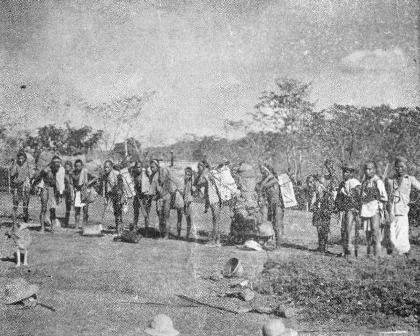 Somewhere in the vast dank jungles of Burma an ICD crew is fighting its way back to civilization. Native
porters loaded with food, clothing and supplies will lead the ground parties in the search for the lost fliers.
Somewhere in the vast dank jungles of Burma an ICD crew is fighting its way back to civilization. Native
porters loaded with food, clothing and supplies will lead the ground parties in the search for the lost fliers.
'Blackie's Gang' Instills Confidence in Air Crews "Will I get back if I have to hit the silk?" is the inevitable question which ICD crew members have asked themselves when they started out over the Hump. The answer to that question goes back to October, 1943, when after repeated crashes and lost flights in jungles and mountains a squadron was organized to handle search and rescue activities. Capt. John Porter, Cincinnati, Ohio, a 27-year-old pilot, became commander of this squadron - the first and only ICD unit exclusively detailed to search and rescue work, to which Porter sacrificed his life. Operating out of Chabua, "Blackie's Gang" - as the outfit became known - is now a part of Hump legend. From Orphan Some idea of the tremendous job which faced Porter and his successors can be obtained from the fact that as of Oct. 30, there have been 586 crashes of all commands in the Hump area, involving search and rescue activity. Of these, 496 have been identified, pin-pointed and closed out completely. As of late October, approximately 90 located aircraft wrecks remained to be reached. The ICD Search and Rescue unit has grown from an orphan outfit with two or three aircraft and little official status to an efficiently organized business employing more than 200 skilled persons. 90 Days Now operating out of Mohanbari, the unit has been responsible for all search and rescue work from Bhamo, in Burma, north as far as allied planes regularly fly. Roughly, its jurisdiction extended from Tezpur, India to Yunnanyi, China. Before organized search and rescue, crews had been lost for weeks, sometimes months. Stretches up to 90 days were not unknown in a country where jungle thickets and dizzy mountain trails made each hour a nightmare to the lost crews fighting their way out. But today, ICD's unique outfit probably would have made the story a trifle less stark. Aerial supply drops of maps and pertinent homing information would have made the walk-out perhaps less circuitous, while certainly the hardships would have been alleviated by air-dropped medical supplies, food and clothing. S & R members have parachuted to lost aircrews to furnish medical aid and walkout assistance. As a direct result of the unit's work, the percentage of saved personnel steadily mounted and with it the confidence and assurance of ICD flight crews. In 1943, its first year of operations, 62 percent of personnel missing from flights over the Hump was rescued. During the first six months of 1944 that figure had increased to 77 percent. Many improvements were initiated in ICD search and rescue. A trail-building project in the uncharted Ft. Hertz valley was one important contribution. Pilots Fly Hump Lanes Detailed on Scale Model 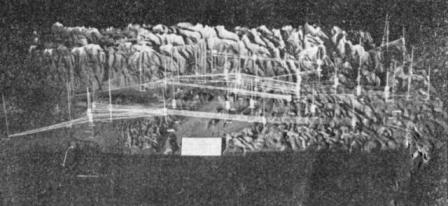 The above scale model details the Hump routes from India's sea level bases (left) to China's mile-high
terminals (right).
The above scale model details the Hump routes from India's sea level bases (left) to China's mile-high
terminals (right).
In the early days of airlifting men and materials to China, ATC's planes flew from Assam valley airfields across a shorter but more dangerous route over and around the higher peaks of the Himalayas. As the Japs were driven southward into Burma, new air lanes over lower terrain were inaugurated. At the same time steadily increasing traffic necessitated vertical spacing of planes and lateral separation of routes, shown on the model, and accurate intervals between aircraft dispatched from China or India, the latter achieved primarily through radio traffic control centers. The main China bases were located on the Yunnan plateau clustered principally about Kunming, the world's busiest wartime airport. Interior Indian fields supplied by rail and truck were augmented by bases in East Bengal, close to the ports. Least impressive in size, but most hazardous to pilots, is the ridge of mountains - the Chin Hills - (center foreground) over which developed the greatest turbulence, heaviest rain and severest icing experienced in this part of the world. |
Haul Tons of
Good Morale
To Men in India And China
While ICD was maintaining a vital supply line to China of gasoline, troops, and equipment, it also was hauling tons of another vital war material - morale.
This was in the form of 21 separate entertainment units sent out by ICD special service to entertain all of the ATC bases in CBI, from headquarters in Calcutta to outposts in Hsian, China.
The program started on Dec. 23, 1944, when the first package of fun and music was sent to help fill the Christmas stockings at four China bases. Next to a case of cold beer, the entertainers were the best thing that could have been sent Chinaside.
Former 'Pros'
In the middle of that Yuletide favorite, "Silent Night," an air raid alert was given at Kunming and the cast was forced to knock off the last eight bars in a slit trench, hoping the Jap pilots appreciated good music. No raid came off, however, and the men finished the show. After the initial troupe bowed in December, a steady stream of shows was piped over the Hump and their performances are some of the better memories carried back to separation centers by China vets.
The units were organized and supervised by Capt. F. G. Tubbs, Capt. Major N. Travers, and T/Sgt. Tony Martin. This trio later was augmented by Capt. Larry Clinton, well-known "Dipsy-Doodler" bandleader, who took over the musical program.
Most of the units were made up of former professional showmen but plenty of good amateur talent found its way to the footlights. All of the performers were ATC GIs and were sent primarily to entertain ATC units. However, the welcome sign was up wherever they went and plenty of other outfits got laughs through courtesy of ICD.
None Too Far, Too Small
Because of the limited air space, the units necessarily were kept small and the accent was on individual performers. Top artists included such singers as Tony Martin and Dick Foote, piano players like Leonard Pennario, Hal Woodall, and Mel Winters, and dancers like Honey Coles and Vince Haydock.
There were other favorites such as Ventriloquist Peter Badrich and his unforgettable dummy, "Sub Private Oscar O'Connor,: and Magicians Eddie Bauer and Beltran Hubbard. Leon Fields headed a stellar list of masters of ceremonies that usually fronted the units. In fact, the units practically ran the gamut of show business from high quality violinists like Artie Young to recitations by Stanley Hamilton, the GI Robert Benchley.
No audience was too far removed or too small. Some of the units played to audiences made up of thousands while one group gave a hospital show in Chungking before only six bed-ridden GIs.
After the first few units completed their tours, letters of praise reached headquarters from COs at China and Bengal wing bases, requesting more shows. Other entertainers were pressed into service until special service was running a virtual oriental Orpheum circuit.
Major Points of Shipping Facts Given
Deployment Series Shows Truth of Personnel Forecasts
Hq., Calcutta - Since V-J Day the Hump Express has carried a series of "personnel stories" - a resume of redeployment of ICD troops. How accurate has been this coverage?
Insofar as the major points are concerned these are the facts:
Sept. 6 - The Express ran an announcement that 2,500 men would form the first group to be returned from this division to the U.S. This was accomplished.
70-Pointers Out
Sept. 20 - The banner-head story said that an attempt was being made to get Chinaside men home by Christmas. All eligible ICD men on that side of the Hump will be on orders for the States before the end of the month. Almost all of them already have received such orders.
Oct. 4 - The lead story predicted, on the basis of headquarters personnel facts, that all 70-point men, with the exception of a few radio operators, would be on orders by the end of October. In all but a few isolated cases this is exactly what took place. This same story stated that all but one-fifth of the division personnel would have Stateside orders by Jan. 1. Every indication is that even fewer men than that will be left after the first of the year.
'Orient' Scrapped
Oct. 11 - The banner head said that 21,000 men would have left ICD by Dec. 1. This week 19,000 already had departed their bases and headquarters personnel states that the figure will be raised to 23,000 before the end of the month. This story also said that all 60-pointers and men with 24 months' service would have orders in November. The point men will have those orders within the next two weeks. Those with 24 months will move to replacement pools unless a new WD eligibility ruling changes present plans.
Oct. 25 - The headline said that men eligible for discharge as of Oct. 1 would be on orders by November. The only exception, said the story, would be about 500 "stragglers." This personnel goal was accomplished.
Nov. 1 - The Express announced that the Orient project was out. Facts in the story remain correct, and the promise to close down all division operations by March 31 will be fulfilled, according to the division personnel section.
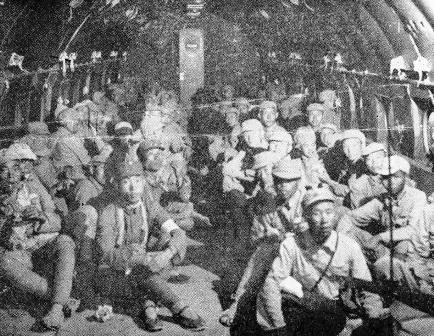 If the homeward-bound GI feels his 39 buddies and their baggage crowd the cabin of a C-54, he should recall the
record mass movement of the 94th Chinese Army to Shanghai. Eighty troops, their arms, field kitchens, mascots were
packed in the same space.
If the homeward-bound GI feels his 39 buddies and their baggage crowd the cabin of a C-54, he should recall the
record mass movement of the 94th Chinese Army to Shanghai. Eighty troops, their arms, field kitchens, mascots were
packed in the same space.
|
Throughout Far East Which Will Help
Postwar Military and Civilian Aviation
Indicated By Flights
The development of ICD aerial activities throws a revealing spotlight upon postwar military and civilian aviation.
Great cargoes have made a byword of ICD's famed Hump, while the airlift of fully-equipped military divisions and entire armies from one front to another in the war against the Japs has necessitated a recapitulation of air transport possibilities.
In late 1944 threatened Yank bases in China were evacuated under the very noses of the enemy. Unarmed ICD transports playing hide-and-seek with Jap forces brought personnel and equipment out of Liuchow, Nanning, Kweilin and Suichwan.
Stopped Cold
In the first movement from one front to another of a strictly ground arm, ICD airlifted the entire New Chinese Sixth Army into action at Chihkiang. Aerial crews logged 1,648 trips, carrying troops and a total cargo of 5,523 tons. Moving animals for the first times, ICD aerial transportation of 2,178 army horses necessitated the building of light but strong stalls in revamped transports.
Movement of the Chinese First Army and associated units from North Burma and Nanning and other places in China during the two months preceding Japan's initial requests for armistice involved the flying of some 50,000 troops and equipment over the Hump.
'Down-Under' Run
In spite of heavy monsoon weather two Hump routes were kept open, with approximately 3,000 flights during the period from June 15 to Aug. 14.
Highlighting the civilian shape of aeronautical things to come, ICD has pioneered new air routes and cut down flying time from many established runs. In February, 1945, ICD C-54s bridged the 3,100-mile gap between Ceylon and Australia to set up regular roundtrip air service between India and the "down-under" allies.
The flight from Ceylon to Exmouth gulf took 15 hours, with seven hours between Calcutta and Ceylon. It was the longest scheduled over-water flight in ATC's globe-circling system.
Night Flights
For more than nine months, ICD planes flew across Jap lines from advance bases in China straight to the Philippines, cutting Calcutta-to-Manila time from 50 hours (by way of Ceylon and Australia) first to 12½ hours and more recently to less than eight hours.
Regularly scheduled night flights of C-54 Skymasters were inaugurated in May, 1945, connecting Free China with allied Pacific bases by means other than radio for the first time since Japanese seizure of coastal areas early in the war.
ICD poured allied occupation elements of the 94th Chinese Army into Shanghai before Jap surrender terms had been signed. Kurmitola and Tezgaon based C-54s took off with their own avigas for the 4,296-mile round trip.
The Skymasters off-loaded the extra gas at Liuchow and picked up Chinese soldiers for the jump to Shanghai, returning to Liuchow to refuel.
The first AAF airplane to land at Singapore following the surrender of that naval base was an ICD C-54. The flight, first of three dispatched from Calcutta on POW evacuation missions, was a 2,000-mile trip over ocean. The last 1,500 miles were flown without the aid of weather reports.
Globester Leg
The first C-54 brought out 40 POWs from what was described by Maj. Edward A. Shaeckel, Lincoln, Nebr., executive officer of the division surgeon's office, as a place of "lice, filth and disease." In the first evacuation were hospital cases, while emergency supplies were left for those who were flown out by later ICD flights.
Since Oct. 1, ICD has been flying the next-to-last leg in the newly inaugurated "Globester" hop, linking North America, Africa, Asia and the Philippines by regularly scheduled flights for the first time in history.
The round-the-world trip operated by ATC normally originates at New York, with stops at Casablanca, Cairo and Karachi before ICD helps complete the hook-up with its "Marco Polo" leg. ICD transports link Asia with the Philippines, a distance of 3,180 miles, about 700 over water.
Gen. Arnold Lauds World-Girdling Trip by ATC Globester
Hq., Calcutta - In a letter forwarded to ICD by ATC Commander Lt. Gen. Harold L. George, Gen. H. H. Arnold, CG, AAF, praised the successful completion of the first "Globester" flight and commended highly all personnel taking part in the mission.
"The fact that the entire trip was handled as a routine flight . . . displayed to the world air power's potential and the need for America to retain her pre-eminence in the air," Gen. Arnold said, and added, "I am confident that the regular schedule will be continued with the same high degree of safety and efficiency."
Gen. George, commenting on the commendation, stated, "The successful completion of the 'Globester' flight is evidence of ATC's contribution to safe, efficient air transportation in the postwar years."
 Sleeping-Beauty Eleanor Parker opens those sultry eyes for the publicity photog on the Brothers Warner payrolls.
Wonder if a poor old beat-up ICD commando and his Brownie camera could make the grade?
Sleeping-Beauty Eleanor Parker opens those sultry eyes for the publicity photog on the Brothers Warner payrolls.
Wonder if a poor old beat-up ICD commando and his Brownie camera could make the grade?
|
Nippon Troops Join
China's Communists
In Civil War Battle
Chungking - Large-scale Jap troops, fully-armed, were reported this week to have joined communist forces at Shankaikwan, at the coastal end of the Great Wall, in the first heavy fighting in China's undeclared civil war.
The internal struggle swelled to major proportions Sunday as Generalissimo Chiang's government threw close to 1,000,000 fighting men into the battle to dislodge crack communist troops, which threatened to oppose their every attempt to land in Manchuria or any :liberated areas" in North China.
Lt. Gen. Albert C. Wedemeyer, U.S. CG in the China Theater, returned from Washington this week and again denied intervention of U.S. forces in the strife, but admitted his troops had been caught in minor skirmishes, Army News Service reported.
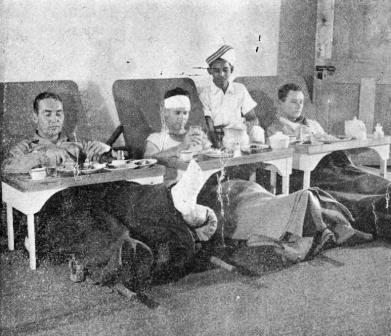 GIs, air-evacuated by ICD, clean up a between-flight service meal before continuing on their trip to a rear
echelon hospital. Inventive ground crews designed the portable back-rests and tables to use indoors or under the
wings of a plane so that patients could remain on their stretchers.
GIs, air-evacuated by ICD, clean up a between-flight service meal before continuing on their trip to a rear
echelon hospital. Inventive ground crews designed the portable back-rests and tables to use indoors or under the
wings of a plane so that patients could remain on their stretchers.
|
Flown Out by Air
By Air Ambulances
Aircraft accounting for almost 100 percent of casualty evacuation from Burma, according to Maj. Gen. David N. W. Grant, U.S. air surgeon, writing in the Air Surgeon's Bulletin moved more than 100,000 CBI patients from 1943 through May, 1945.
British, Indian, Chindits, Chinese and Yanks were among the personnel airlifted. In the peak month of March, 1945, the total reached nearly 16,000.
Medical air evacuation by war's end had developed into a considerably stepped-up version of mere routine services. Trips from forward bases in China to Calcutta's modern hospitals in less than five hours have been typical of ICD "flying ambulances."
Doubled Strength
Operating feeder airlines into advanced outposts from which overland evacuation would further endanger patients' lives, hospital planes funneled ailing Chinaside GIs into Kunming, where C-54s continued the journey over the Hump to India. Trans-India flights from Ledo, Chabua and Calcutta brought patients to Karachi for removal to the States.
The division had more than doubled its strength in less than one year of operations. This unique development demanded a constant fluidity of the functions of the medical department. As new operations against the enemy were conceived and new bases activated, medical personnel had to be strung out along thin lines in order to counter a demand which was daily exceeding the supply. Regular cargo planes were equipped to handle litter cases on a few moments' notice.
Attempts to solve the problem of air travel of medical evacuees finally were crystallized early in 1943. To Chabua in October of that year came the 803rd Medical Air Evacuation Transport squadron, with physicians, surgeons, nurses and medical technicians.
POW Evacuation
In July, 1944, the 803rd was joined by the 821st MAETS. Personnel and material of both organizations were under the operational guidance of ICD. Flights of both units were stationed in China and Burma, and a flight each was attached to the 10th and 14th Air Forces.
The recent evacuation of POWs after Japanese capitulation was but a small segment of the overall pattern of the ICD "hospital run." During the close-in fighting in Burma the removal of casualties to rear area hospitals was one of the theater's large-scale operations. Medical personnel worked within gunshot range of the enemy and many were listed among the wounded. In addition, some of the emergency evacuations from small advanced bases made headline and history by their daring and resourcefulness.
Distinctive Heroism
MAETS personnel have piled up impressive logs of flying hours. Some surgeons have more than 500 hours to their credit - more than many combat crews - while flight nurses have averaged better than 150 hours. Much of this time has been logged as combat, because of the proximity of MAETS work to enemy lines. Prompt and skillful treatment by air evacuation personnel en route on planes has saved many patients' lives. Not one loss of life has been chalked up to accidents while aboard ICD hospital aircraft.
At the end of the war the record of ICD medical evacuation squadrons stood at more than 133,000 evacuees, according to the Air Surgeon's Bulletin. But if much of the work of these squadrons remains unsung, it is probably because fame is a poor antidote for illness. Only in the citations of Soldier's medals, Bronze Stars and other awards which have been presented to MAETS officers and enlisted men may the true, untold story be found: ". . . for distinctive heroism . . . meritorious achievement . . ."
Space Ships To Be Used
Comic Strip Type Planes Will Become Reality, Declares Arnold
Washington (ANS) - Space ships moving outside the earth's atmosphere and capable of launching atomic bomb rockets on any enemy "unquestionably will be brought into being within the foreseeable future," Gen. H. H. Arnold said this week.
The commanding general of the Army Air Force mentioned space ships - now existing only in comic strips - as the counter weapon if defenses are developed against 3,000-mile-an-hour rockets delivering atomic explosives.
"The design of such a ship is all but practical today," Arnold said in a summary of air war and recommendations for the future which he prepared for War Sec. Robert Patterson. It was his third and perhaps last report as the head of the air forces.
Arnold, who has expressed his intention of retiring soon, proposed that the U.S. continue to develop the type of strategic bombing used in World War II, and in which America is "the recognized master," until improved anti-aircraft defenses make it impracticable.
Arnold said the U.S. should be ready with a weapon of German V-2 type - rocket-launched projectile that traveled some 3,000 miles an hour and went from 50 to 60 miles high.
For defense against atomic bombs Arnold suggested a three-point program - make certain they are not being produced secretly anywhere in the world, devise every possible way to intercept one after it has been launched and redesign the country for a minimum vulnerability to atomic bomb attack.

|

|
Au Revoir
"This is the initial issue of the Hump Express ...," began the lead editorial in the first issue of the Express which rolled from the presses 43 weeks ago.
This is the sequel to that editorial - this is the final edition of the Express.
The paper came into existence with the avowed purpose of gaining recognition for the men of ICD and for furnishing entertainment and information. It was to be a "family" paper published solely for the men of our division.
The life of the Express can be divided into several distinct periods. The first period was that spent trying to solve problems of production in a non-English-speaking, non-American-maluming print shop.
The second period came when the Express was growing out of babyhood, laboriously finding the type of features, news and editorials the men wanted.
The third period was the "reform" period in which the Express fought for rotation, rest camps in China and anything that would improve the morale of the enlisted men. It was during this period that a staff member overheard a GI tell his buddies, "Just wait till Hump Express and Yank hear about that, then you'll see some fur fly!
About the time the war in Europe was drawing to a close, in answer to the clamor from the men in the field, the Express started furnishing news of the whole world.
The final period came when once again the ball had rolled around and ICD and War Department news concerning points, transportation home and release was what the readers wanted. The editorial policy changed from batting for better conditions for GIs to discussing the questions on every mind - how to prolong the peace, how to make ours a better world.
On the last press day of the Express, two of the four enlisted "founders" could be seen slowly writing the last lines of copy and reading the last proofs with an air of nostalgia. These two, putting the paper to bed for the last time, were the only ones left of those who had helped nurse the first issue into being last January.
Like the Hump operations for which it was named, the Hump Express has completed its mission. The war has ended. ICD will soon be through. Hump operations are over. This ends the Hump Express. Au Revoir!
GI Army Plan
Out of the rancor which the GI has developed towards the present army caste system good may yet come.
The outcry against a military system which separates men into classes is no manifestation of a mass inferiority complex. Nor is it corrosion of thinking as some who bask in the plush luxury of the military upper strata would have one believe.
Americans have been accused of being eternally dissatisfied with their way of life. It is a label which we wear proudly. For this is the yarn of which success is spun.
Today the millions of enlisted men who have seen service in the war army are dissatisfied with an outmoded system which draws a line of demarcation to divide its household into Patrician and Plebeian classes. The American people in uniform are asking for alterations.
We would not condone those who scream hatred against officers as a group. This is but a mental scab which the system has created. Admittedly, there are those who have been so embittered by service in the draft army that their ability to seek a solution is warped. These are the ones who flaunt only their dislike for rank.
Their opinions, like those of officers who take a bigoted, selfishly blind stand in opposing any change, are not the ones which thinking Americans should consider.
Rather we should seek solution of the problem through a mutual co-operation of thought. We suggest these changes:
1. The promotion system in the army should be revamped to make the jump from master or first sergeant to warrant officer, then to second lieutenant a normal procedure. There should be no ceiling placed on a soldier's ability to go forward. The same man who has shown enough ability and leadership to reach the top enlisted grade should be capable of doing a creditable job as an officer. However, no promotion should be made to any rank without careful, thoughtful consideration by a qualified board of personnel experts.
2. Duplicate systems of messing and billeting should be installed to insure equally good food and quarters for those who serve the same country. This is not to decry the officers' per diem system which enables them to buy superior food. Indeed, if this be the best method, all we could ask is as much for the GI.
3. The army should eliminate the system whereby an officers' word is accepted as the whole truth while proof is demanded for any statement by an enlisted man. The officers' word is wreathed in a halo of truth issued with his commission. The GI labors under the stigma of being a small boy who cannot be trusted unless some officer is willing to vouch for him.
4. Special privileges, such as the facility with which officers obtain recreational vehicles, should be leveled to those accorded enlisted men.
5. No public place open to officers should be designated as "out of bounds" to any GI. On the other hand there is no objection to officers' clubs or to any other social gathering which officers may restrict themselves. The GI reserves the privilege of doing likewise.
6. The army should adopt a single uniform for both officers and enlisted men, with authorization for each to wear a common "dress" uniform when not on duty.
A final suggestion, unlike the previous ones, is intangible. But none could be of more importance in the molding of an army which is strong through co-operation between leaders and those who serve under them.
We should be smart enough to realize that for the most part the army can be conducted like any successful business. Personnel differences should not be dismissed with a brusqueness which breeds indifference to the job.
Army officers should discover what business leaders long have known - that tact and courtesy can buy unlimited co-operation and a sincere application to duty. Those officers who have dared to be different - who have dared to practice this principle - are those whom today's GI will remember as his real leaders.
There are other alterations - the metamorphosis towards perfection is a process which should never know stagnation.
But for the present these are the changes most GIs would like to see. With the application of the new system the U.S. can realize its dream of a more intelligent standing army.
Until such changes are accomplished one could hardly expect a thinking man to submit himself in time of peace to a military caste system which denies him his rights as an American.

|
Editor:
It has come to the attention of this office that this base does not receive your newspaper, Hump Express . . . Many were the requests for the Express in the last few days; therefore we feel anything you can do . . . will definitely be a contribution towards higher morale for all.
1st Lt. Gordon Wiggins, 1364 BU, Canton
Editor:
Your paper, the famous Hump Express, is much missed in this end of Cathayland. I haven't seen a single copy for weeks now . . . Something should be done to put a stop to this suffering . . . I'm dying unless a few copies of the Express are sent this way . . . The men are going insane without the mental comfort of its pages . . .
Cpl. Humberto Borges, 1364 BU, Canton
Leave Pay for EM
Editor:
From time to time articles have been published which mention a bill recently introduced in Congress to establish a system of terminal leave pay for enlisted personnel. All articles have been vague in their treatment of the subject matter of the proposed legislation. Since such a law would be of great interest to EM, information is requested as to the scope of such a plan. How would it affect us as individuals?
M/Sgt. Paul R. Lowry, S/Sgt. Ralph Monroe, 1300 BU, Calcutta
Ed. - The legislation referred to is HR 4422 proposed by Rep. John C. Kunkel (R-Pa.) which would grant terminal leave payment to enlisted personnel of the armed forces, totaling two and one-half days per month for every month of service during the war. The legislation would give enlisted personnel the same leave status now enjoyed by officers and civilian employees. This is one of the outstanding pieces of legislation as yet proposed effecting enlisted personnel.
Stilwell Road Points
Editor:
Are the men who were on TDY to drive trucks . . . over the Stilwell and Burma Roads entitled to any of China's campaign star awards? . . . Orders were cut starting May 26 and we were given 30 days to complete the mission, destination Kunming . . . The non-com in charge of adjusted service ratings said the only men in India to receive China stars were flying personnel . . .
Pfc. Lou Lipman, 1306 BU, Karachi
Ed. - Routes over Stilwell and Burma Roads from Misamari to Kunming were not in the China offensive combat zone in May, 1945. China offensive campaign does not limit itself, however, to flying personnel.
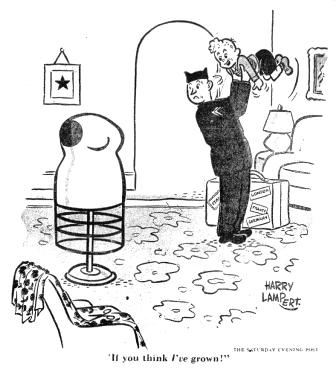
|
| |
|
|
Nowhere in China is there a better place to live than in the coastal city of Soochow. Affording comfort, enjoyment and convenience, famous for its scenic beauty as well as its talented and lovely women, Soochow, before the war, afforded a comfortable life at low cost. Said the Chinese: "Like paradise in heaven are Soochow and Hangchow on earth."
Lying Between Shanghai and Nanking, Soochow is a resort for the people of both cities.
Before the war the girls of Soochow and Peiping were considered ideal as wives by the young men of China. Soochow girls were good humored, pretty. They speak musically, are good housekeepers and hard workers.
No Fisticuffs
Famous for its girls, Soochow is also noted for its men of literary genius. Literature has flourished in the city for more than a thousand years. Soochow men, however rich in thought, are slight in stature. Quarrels among them seldom finish in fisticuffs and the best fighting men of China are found elsewhere.
Many small streams flow from Soochow to other cities. One connects the city with Shanghai and on it sail small steamships, sampans and junks. Another narrow stream links Soochow with Tung Ting Shan, which during the war became a sanctuary for refugees of Shanghai.
Soochow was the capital of the Dukedom of Wu during the time of the warring kingdoms. Not until the Sui dynasty in the seventh century did the town become a city and adopt the name "Soochow." Ever since, it has remained populous and prosperous through the development of trade and commerce, though it has never been an industrial center.
Educational Strides
Next to Shanghai and Nanking, Soochow has made greater strides in education during the past 40 years than any other city in Kiangsu. It has a university, several normal schools and hundreds of elementary schools. A committee of high school teachers of English in Soochow had an important influence on the teaching of English in China by editing and compiling its own textbooks for high school use.
Chapel Bell
When Soochow fell to the Japanese early in the war the removal of a bell from Soochow chapel to Japan was one of the first acts of the invaders. This bell was a thousand years old and had been kept in the "Cold Mountain" chapel since the T'ang dynasty. A poem written by the wise poet Chang Chi of the Tang dynasty and widely read both in China and Japan had made the bell famous.
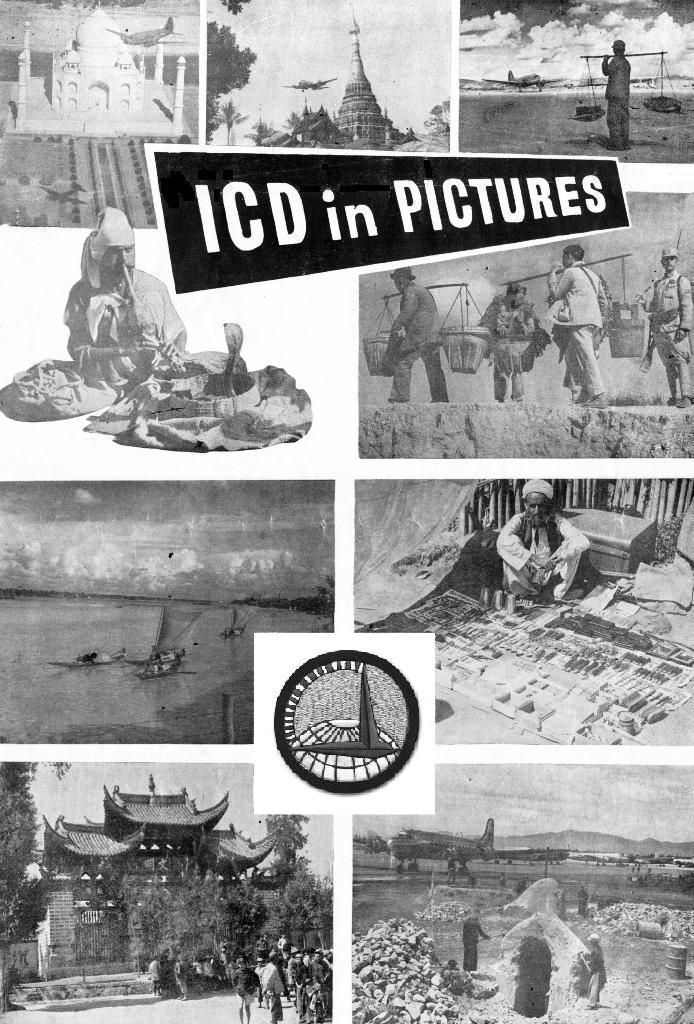
Just as the peoples of India, Burma and China have come to know the friendly roar of ICD planes carrying the goods of war over their heads to the eastern fighting fronts in China, so ICD men have become accustomed to such local sights as sampans, yoke-laden coolies, snake charmers, pagodas and street vendors. On this page and the following three pages are familiar sights of the "strange lands" in which the Yanks have found themselves in recent months, and the pictorial story of ICD, its men, machines and missions.
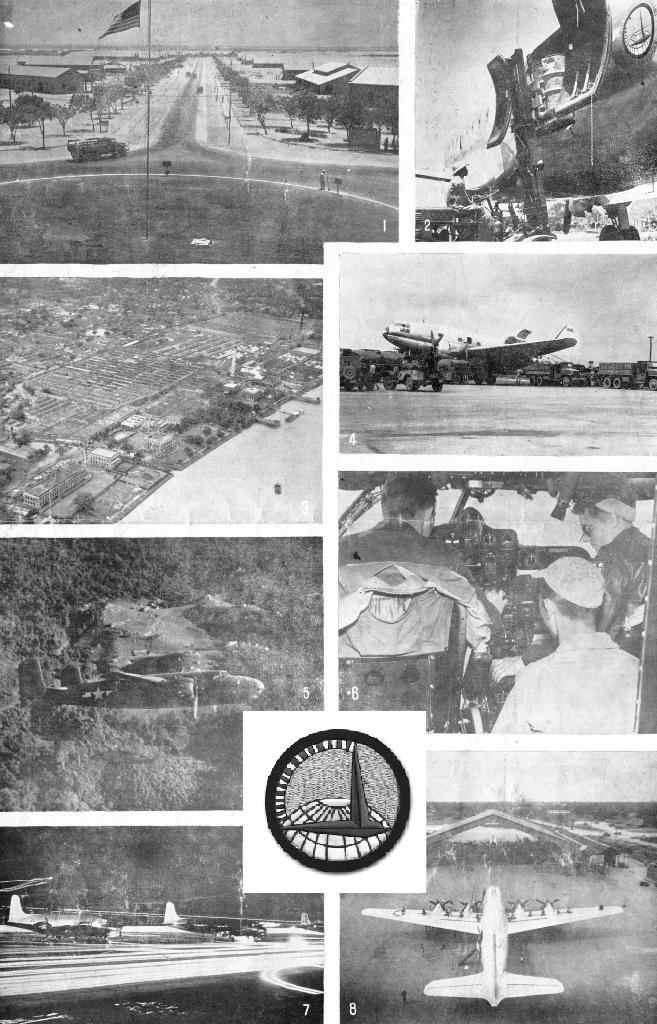
1. Karachi airbase, aerial gateway to and from India, as seen from the tower. 2. Man and machine fork-lift drummed gasoline, vital cargo, into a C-54. 3. Hastings Mill, near Calcutta, is headquarters and nerve center of ICD's vast operations which spread, weblike, over three countries and connect with others. 4. "Turnaround" - servicing, unloading and reloading of aircraft at lightning speed - makes precious minutes count. 5. A Search and Rescue unit B-25 circles a Naga Hills village seeking downed fliers. 6. An essential, in efficient operations, is good training prior to checking out air crew members. 7. Around-the-clock operations crisscross fields from India to China with light patterns as planes taxi, take off, land. 8. Production line maintenance keeps planes flying; typical is this C-54, civilian maintenance men clambering over wings and engines.

1. Passengers board a C-54 Skymaster at the Karachi terminal. 2. A Jap guard disconsolately views the arrival of an ICD transport bearing 94th Chinese Army troops to Shanghai. 3. Even horses were flown over the Hump to China in the war against the Jap. 4. A patient is evacuated to safety where adequate medical care is available. 5. Always buzzing is the operations office with its telephones and blackboard. 6. C-54s at the Kurmitola ramp await loading for another Hump hop. 7. C-46 Commando engines get a going-over on the line. 8. Chinese 94th Army troops load their arms and equipment for the run from Liuchow to Shanghai. 9. Symbolical of ICD's job is this C-46 flying the "rock-pile," as rough a bit of terrain as there is in the world.
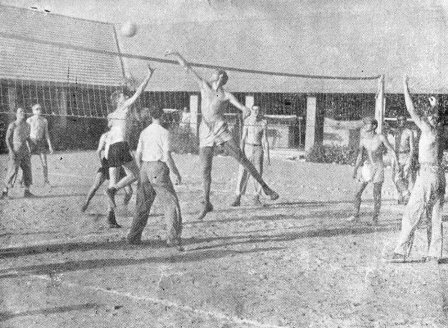
|
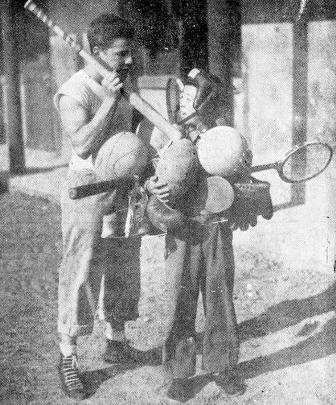
|
 Officers and men of ICD, who did most of their traveling above the clouds, solved the problem of scarcity of
ground transportation in China last June by driving vehicles from Assam to Kunming, along the Stilwell Road, in a giant
convoy.
Officers and men of ICD, who did most of their traveling above the clouds, solved the problem of scarcity of
ground transportation in China last June by driving vehicles from Assam to Kunming, along the Stilwell Road, in a giant
convoy.
|
A three-way aerial traffic control system regulating transport-laden China skyways has made Kunming a working replica of Stateside airfields, playing no small part in successful ICD high tonnage lifts over the Hump.
Since October, 1943, China's busiest airport has been meeting the problem of congested air traffic due to increased tonnage movements with a system called "air traffic control," made up of tight area, air and approach checks. By this system, aircraft are completely controlled, first on the long flight across the Hump, then as they approach their destination, and finally, down onto the field itself.
Expedites Operations
As used at Kunming, "area control" assists in receiving traffic or, in necessary cases, diverting it to other Chinaside bases to prevent overloading fields beyond their capacity. "Air traffic control" separates aircraft on instruments in order to prevent mid-air collisions, plots progress of all en route aircraft, and renders assistance to planes in emergencies.
"Traffic" clears a plane to "approach control" when it is within 25 miles of its destination. This third and last part of the three-phase program expedites arrivals and departures of aircraft, under conditions of reduced visibility, by direct contact between plane and a controller who issues necessary instructions to the pilot concerned. Thus transports arrive at and depart the Kunming area nerve-center in the shortest possible safe time.
Searchers, Too
Of interest is the manner in which "air traffic control" makes possible the tracing of lost aircraft. Checkpoints along the lines of flight are provided with ETAs of en route aircraft, and the Kunming center is furnished the time and place of departure as well as the estimated time of arrival of each China-bound transport.
If an incoming aircraft has lagged behind its Kunming ETA, satellite Chinaside fields are sent tracers requesting information concerning its whereabouts. If replies are negative, this is relayed by the Kunming center to the aircraft's base of departure. Contact is made with operations both at the home base and the plane's destination, search and rescue squadron and wing headquarters are notified, and the search for the lost plane is started.
These three procedures have been responsible for the safety of China-bound transports. In a theater where adverse weather conditions add to the perils of normal Hump operations. at times causing the "stacking" of as many as 50 incoming planes at 500-foot levels, there has been no record of mid-air collision where ground-to-air instructions were obeyed.
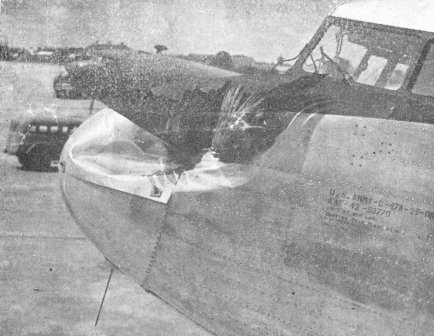 Vultures took up where the Japs left off when, during the latter part of August, they opened undeclared warfare
on Dum Dum planes. This mid-air collision with a C-47 took place 7,000 feet above 1305 BU, with the divebomber's
head going through the metal skin of the plane's nose and dangling almost to the control pedals. Crewmen escaped
injury.
Vultures took up where the Japs left off when, during the latter part of August, they opened undeclared warfare
on Dum Dum planes. This mid-air collision with a C-47 took place 7,000 feet above 1305 BU, with the divebomber's
head going through the metal skin of the plane's nose and dangling almost to the control pedals. Crewmen escaped
injury.
|
Washington (ANS) - ATC's speed of personnel demobilization has forced the air corps to cut the number of its trans-Atlantic flights almost in half during the last two months, command officials said this week.
ATC reported its planes now are making a daily average of 19 crossings, compared with 35 in early September, with a further decrease forthcoming. Operations on other routes in the command's global system also are being reduced.
Since V-J Day, approximately 50,000 ATC persons have gone to separation bases, with many men leaving through other channels overseas. Rate of release, ATC officials said, is far more rapid that that originally expected.
"In order to operate safely on long over-water flights," ATC said, "flight crews and ground control personnel of practical experience on those routes are required. The only substitution for this desired experience is extreme caution resulting in the carrying of extra gasoline and strict interpretation of weather forecasts. These cautions have resulted in reduced payloads and frequency of flights."
The rapid discharge of men has had its effect on aircraft maintenance at ATC bases, although the command is attempting to offset some of this by putting the remaining experienced men in key supervisory jobs, the officials said.
The cutback in ATC's Atlantic service is being compensated in steadily-growing measure by inauguration of regular commercial lines.
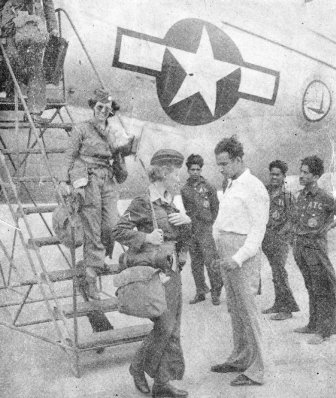 Two of the first ATC WACs to arrive in India last June, Pvt. Mary E. Griggs (on steps) and Pfc. Margaret McCombs
were happy to leave the C-54, which carried them from LaGuardia Field, N.Y., to Karachi, and find out what India is
like.
Two of the first ATC WACs to arrive in India last June, Pvt. Mary E. Griggs (on steps) and Pfc. Margaret McCombs
were happy to leave the C-54, which carried them from LaGuardia Field, N.Y., to Karachi, and find out what India is
like.
|
Baksheeshland Farewell
By Cpl. Ve' Grable (WAC)
India, as all Yank "visitors" know, is a country of many tribes.
These tribes, the adventurous and exploring visitors admit, are interesting. For instance, there are the Hurs around Karachi, formerly known as "headhunters," the fierce Nagas who roam the countryside between Burma and Assam and the Garhwals who live in the United province.
On June 23, just four and one-half months ago, there arrived in India a new tribe which the Yanks soon found to be far more attractive than the colorful and age-old clans in Baksheeshland. This was a tribe which became known as the "Indiawacs."
Still Wondering
The Indiawacs, like the native tribes, from the first were very interesting to the Yanks. They were a bewildered and excited group, moved by strange and curious emotions. Else why, the exploring tribe-investigators questioned, should they choose to leave Sugarcountry, their native home, for the land of the Indians?
Some Yanks, being a little slow, are still wondering. And were it not for the great pride of the tribe-women they, too, now might wonder a bit. Already, in whispers and in dark corners, a few have been heard to declare that India is a "stinkin' hole." But that epithet, although there are men who claim it is no exaggeration, was far from the women's thoughts when they stepped happily out on the Karachi ramp last June.
"How lucky we are," they chanted, "to be overseas, in the land of mystery and romance. What tales can we carry home?"
The spiritual beauty of mysterious India momentarily was forgotten as the women became aware of the physical presence of many waiting, hungry men (later known as "ravishing, famishing, would-be wolves).
The men, who belonged to the same North American tribe as the Indiawacs, had retained pleasant memories of the group's civvy-sisters and were eager to make friends with these women, believing that beneath their HBT-uniforms they were exact counterparts.
And so they came, the Indiawacs, until soon there were over 150 in the monsoon country. They made little brick buildings, where once the officer clan had lived, their home. The Yanks, believing members of the Big Brother species, helped them greatly building iceboxes, clothes racks, foot-lockers and, as their escorts, protecting them from dangers in the strange country.
Awe-Struck
The first week in July, a little group of 30 or so were sent to live at Hastings airbase and study Indian life at Calcutta. This group, known as the "Calcutta Cuties," moved into the "camouflaged" jute mill in one big room with many other WACs - old-timers of the AAF and ASC branches - each with a little area to set up housekeeping. Then, with all the tribeswomen settled, the Calcutta cuties and the "Karachi kids" set out to unravel the mystery of India and Yanks overseas.
The women, although seemingly timid and awe-struck, were in reality courageous and brave to have flown over to the strange land which has been their "summer home." An appalling picture of life in India, of dangerous insects, crawling snakes, wild natives and hungry GIs had been painted.
"Do not kiss the soldiers," the Sugarcountry khaki-sages had ordered, "until the have had their mouth, teeth and gums inspected." Then the women had been given instruction in ju-jitsu, to protect them from any unknown dangers.
'Very Satisfying'
The dangers, the cautious WACs soon discovered,
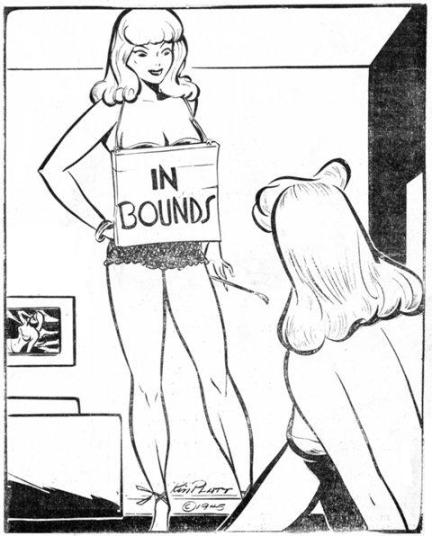 "I want him to know he's REALLY out of the Army!"
"I want him to know he's REALLY out of the Army!"
|
So on the whole, the Indiawacs admit, Baksheeshland has been very satisfying, "no kidding." They've trained their ayahs, the little Indian maids, and readily have accepted a life of domestic ease.
There have been temples to visit and gods to see, Hindustani to study and much to write home about, such as their command of such native words as "malum" and "teek."
Not that the Baksheesh life has been all play for the girls. They have worked hard doing jobs similar to those which the Yanks have done for so long. They type and file, take dictation and drive vehicles; one girl is a link trainer instructor and another a welder. Section wallahs have reported they are greatly pleased with the new tribe and thoroughly approve its migration to India.
But now that the big fight is over (which was what the Indiawacs migrated for) the tribeswomen have decided that India's enticements have vanished as has their desire to unravel the country's mysteries. Although they hastily and vehemently will chant they are glad they came, that India has been fun, the men "very, very nice," and their good memories many, lately the colorful atmosphere seems to have disappeared and left only its "smell."
Now, at unguarded moments and with looks in their eyes similar to those of the long-time visitors, the Indiawacs have been heard to express the wish to return to their native clan in America, to belong to the big tribe known as civilian women. And the exploring Yanks, who were so interested in why they should leave their own land, do not find this unusual in the least. They have somewhat the same desire themselves.
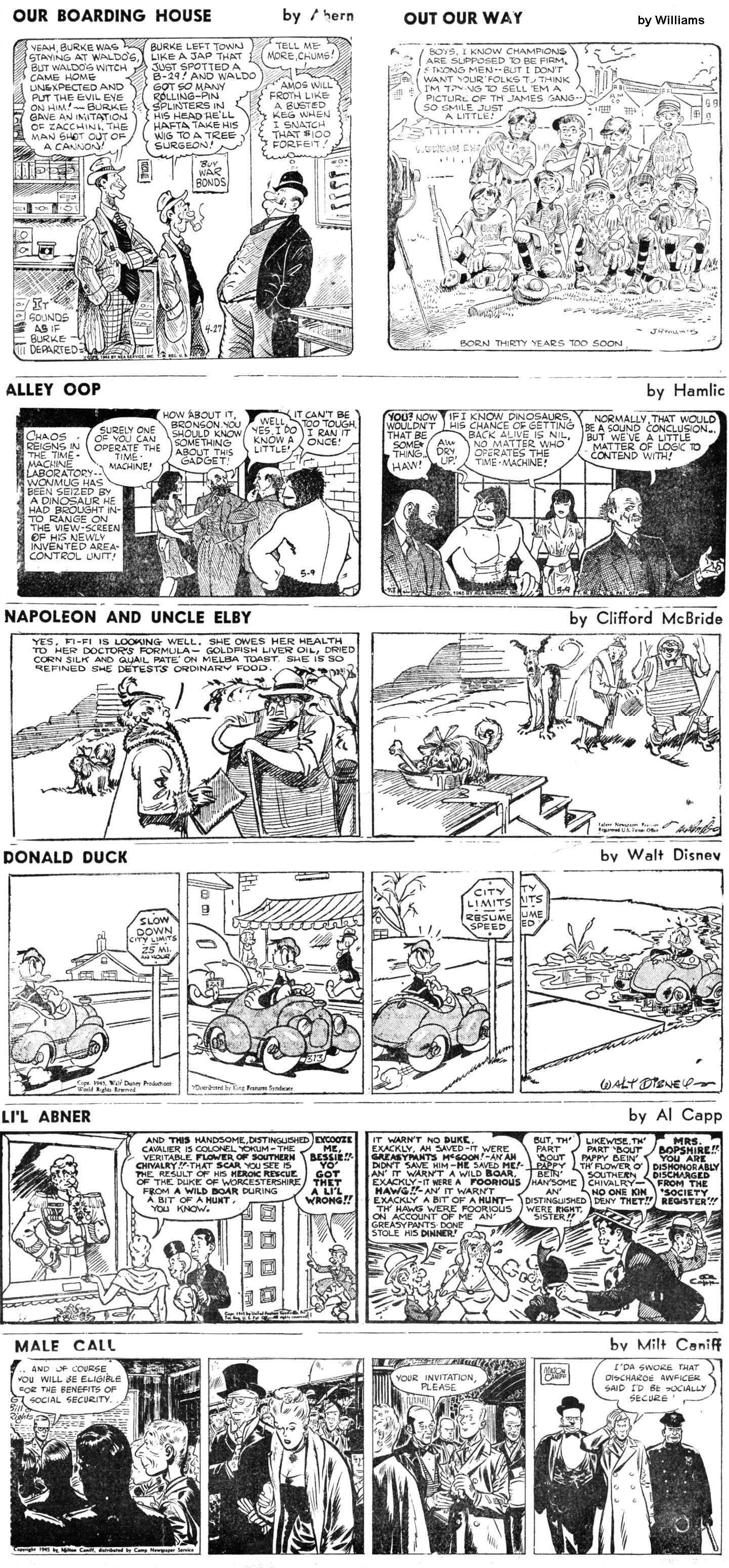

|

|
HUMP EXPRESS is the official newspaper of the India-China Division, Air Transport Command, APO 192, c/o Postmaster, New York, N.Y., and is published by its Public Relations office. Officer-in-charge Maj. Miles Scull, Jr.; Editor-in-chief, T/Sgt. Gordon R. Lewis; Staff: S/Sgt. Floyd E. Matteson, S/Sgt. Bill Graham, Cpl. Ve' Grable. Camp Newspaper Service and Army Newspaper Service features are used, reproduction of which is prohibited without permission of CNS and ANS, 205 East 42nd St., New York, 17, N.Y. Material is submitted by ICD-ATC base Public Relations sections and other soldier correspondents. Printed weekly by N. N. Sengupta, from the Hindusthan Standard, 3-C Burman St., Calcutta, India, and distributed each Thursday.
| Necessary subsistence for U.S. troops still in China . . . military transport of cargo, personnel and mail across India . . . and evacuation of American troops to ports of debarkation and home - these are the missions of ICD-ATC. |

NOVEMBER 15, 1945
Original issue shared by Jay Cobb on behalf of his father
CBI veteran James R. Cobb CWO-4 USAF (Ret)
Copyright © 2009 Carl Warren Weidenburner
SEE THE ORIGINAL
TOP OF PAGE PRINT THIS PAGE ABOUT THIS PAGE E-MAIL YOUR COMMENTS
PREVIOUS ISSUE HUMP EXPRESS BASE FIRST ISSUE
